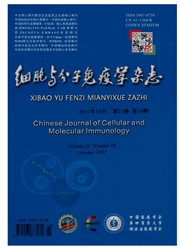

 中文摘要:
中文摘要:
目的研究银屑病患者外周血嗜酸性粒细胞P物质(SP)及其受体神经激肽/速激肽受体1(NK1R)的表达。方法流式细胞术检测银屑病患者和健康人外周血SP和NK1R的水平;用(0.1、1)μg/m L的蒿草花粉、梧桐花粉和尘螨过敏源粗提液刺激后,流式细胞术检测银屑病患者外周血嗜酸性粒细胞SP和NK1R的水平。结果银屑病患者SP^+和NK1R^+嗜酸性粒细胞的比例分别升高2.7倍和0.5倍,平均荧光强度分别增加1.5倍和0.2倍。此外,1μg/m L梧桐花粉过敏源粗提液刺激后,SP^+嗜酸性粒细胞的百分比下调60%,而0.1μg/m L梧桐花粉过敏源粗提液刺激后NK1R^+嗜酸性粒细胞的比例升高0.6倍。结论银屑病患者血液嗜酸性粒细胞SP和NK1R水平升高。
 英文摘要:
英文摘要:
Objective To investigate the expressions of substance P( SP) and its receptor neurokinin/tachykinin receptor 1( NK1R) in peripheral blood eosinophils of patients with psoriasis. Methods The levels of SP and NK1 R in the peripheral blood of both patients with psoriasis and healthy people were detected by flow cytometry. This method was again used to detect the levels of SP and NK1 R in the peripheral blood eosinophils of patients with psoriasis after stimulated with the crude extracts of Artemisia pollen,dust mite and Platanus pollen( all at concentrations of 0. 1 and 1. 0 μg/m L). Results Compared with the healthy controls,the percentages of SP^+and NK1R^+ eosinophils in psoriasis patients increased up to 2. 7 and0. 5 folds,respectively. Moreover,the mean fluorescence intensity( MFI) of SP+and NK1R^+eosinophils of psoriasis patients were elevated by 1. 5 and 0. 2 folds,respectively. The percentage of SP^+eosinophils in psoriasis were down-regulated by60% after the stimulation with Platanus pollen extract( 1 μg/m L),while 0. 1 μg/m L Platanus pollen extract induced a 0. 6-fold increase in the percentage of NK1R^+eosinophis. Conclusion The expressions of SP and NK1 R are up-regulated in peripheral blood eosinophils of patients with psoriasis.
 同期刊论文项目
同期刊论文项目
 同项目期刊论文
同项目期刊论文
 Expression of the American cockroach allergen Per a 9 in insect cells: comparison with its counterpa
Expression of the American cockroach allergen Per a 9 in insect cells: comparison with its counterpa 期刊信息
期刊信息
